Acute abdominal pain resident survival guide: Difference between revisions
Gerald Chi (talk | contribs) No edit summary |
Amr Marawan (talk | contribs) No edit summary |
||
| (38 intermediate revisions by 3 users not shown) | |||
| Line 1: | Line 1: | ||
<div style="width: 80%;"> | |||
__NOTOC__ | __NOTOC__ | ||
{{ | {{CMG}}; {{AE}} {{AM}} | ||
{{ | |||
== | {| class="infobox" style="margin: 0 0 0 0; border: 0; float: right; width: 100px; background: #A8A8A8; position: fixed; top: 250px; right: 21px; border-radius: 0 0 10px 10px;" cellpadding="0" cellspacing="0"; | ||
|- | |||
! style="padding: 0 5px; font-size: 85%; background: #A8A8A8" align=center| {{fontcolor|#2B3B44|Acute Abdominal Pain Resident Survival Guide Microchapters}} | |||
|- | |||
! style="font-size: 80%; padding: 0 5px; background: #DCDCDC" align=left | [[Acute abdominal pain resident survival guide#Overview|Overview]] | |||
|- | |||
! style="font-size: 80%; padding: 0 5px; background: #DCDCDC" align=left | [[Acute abdominal pain resident survival guide#Causes|Causes]] | |||
|- | |||
! style="font-size: 80%; padding: 0 5px; background: #DCDCDC" align=left | [[Acute abdominal pain resident survival guide#Management|Management]] | |||
|- | |||
! style="font-size: 80%; padding: 0 5px; background: #DCDCDC" align=left | [[Acute abdominal pain resident survival guide#Do's|Do's]] | |||
|- | |||
! style="font-size: 80%; padding: 0 5px; background: #DCDCDC" align=left | [[Acute abdominal pain resident survival guide#Don'ts|Don'ts]] | |||
|} | |||
==Overview== | |||
[[Abdominal pain]] (or stomach ache) is a common symptom associated with transient disorders or serious disease. Diagnosing the cause of abdominal pain can be difficult, because many diseases can cause this symptom. Most frequently the cause is benign and/or self-limiting, but more serious causes may require urgent intervention. | |||
[[Acute abdominal pain]] is a severe, persistent abdominal pain of sudden onset that is likely to require surgical intervention to treat its cause. The pain may frequently be associated with [[nausea]] and [[vomiting]], [[abdominal distention]], [[fever]] and signs of [[shock]]. | |||
==Causes== | ==Causes== | ||
===Life Threatening Causes=== | ===Life Threatening Causes=== | ||
Life-threatening causes include conditions which may result in death or permanent disability within 24 hours if left untreated. | |||
* [[Abdominal aortic aneurysm]] | |||
* [[Acute bowel obstruction]] | |||
* [[DKA]] | |||
* [[Ectopic pregnancy]] | |||
* [[Mesenteric ischemia]] | |||
* [[Myocardial infarction]] | |||
* Perforated viscus (including [[peptic ulcer]], bowel, esophagus, or appendix) | |||
* [[Placental abruption]] | |||
* [[Splenic rupture]] (It is usually secondary to trauma, [[EBV]] or [[leukemia]]) | |||
* [[Volvulus]] | |||
===Common Causes=== | ===Common Causes=== | ||
*[[Acute pancreatitis]] | |||
*Adnexal pathology (cyst or tumor that caused torsion, bleeding or rupture) | |||
*[[Appendicitis]] | |||
*Biliary disease ([[Acute cholecystitis]]) | |||
*[[Bladder distension]] | |||
*Chronic [[heroin]] or [[morphine]] use | |||
*[[Crohn's disease]] | |||
*[[Diverticulitis]] | |||
*[[Dyspepsia]] | |||
*[[Endometriosis]] | |||
*[[Endometritis]] | |||
*[[Hemophilia]] | |||
*[[Hiatus hernia]] | |||
*High dose [[steroids]] | |||
*[[HIV infection]] (affecting the GI and hepatobiliary systems) | |||
*[[Kidney stones]] | |||
*[[Mesenteric infarction]] | |||
*[[Pelvic inflammatory disease]] | |||
*[[Peritonitis]] | |||
*[[Sickle cell disease]] (as a part of vasoocclusive crisis) | |||
*[[Splenic abscess]] | |||
*[[Splenic infarction]] | |||
*[[Ulcerative colitis]] | |||
==Management== | |||
====Diagnostic Approach==== | |||
== | Shown below is an algorithm depicting the diagnostic approach of acute abdominal pain. <br> | ||
{| | <span style="font-size:85%"> '''Abbreviations:''' '''ACS:''' Acute coronary syndrome; '''AAA:''' Abdominal aortic aneurysm; '''RUQ:''' Right upper quadrant; '''RLQ:''' Right lower quadrant; '''LUQ:''' Left upper quadrant; '''LLQ:''' Left lower quadrant</span> | ||
{{familytree/start |summary=Acute abdominal pain}} | |||
{{familytree | | | | | | | | | | | | | | A01 | | | | | | | |A01=<div style="float: left; text-align: left; width: 20em; padding:1em;">'''Characterize the pain:'''<br> | |||
:❑ Onset (eg, sudden, gradual) | |||
:❑ Provocative and palliating factors (eg, Is the pain related to your meals?) | |||
:❑ Quality (eg, dull, sharp, colicky, waxing and waning) | |||
:❑ Radiation (eg, to the shoulder, back, flank, groin, or chest) | |||
:❑ Site (eg, a particular quadrant or diffuse) | |||
:❑ Pain location may change over time, reflecting progression of disease | |||
:❑ Intensity | |||
:❑ Time course (eg, hours versus weeks, constant or intermittent)<br> | |||
'''Other symptoms'''<br> | |||
:❑ [[Nausea]] & [[vomiting]] | |||
:❑ [[Diaphoresis]] | |||
:❑ [[Anorexia]] | |||
:❑ [[Fever]] | |||
:❑ [[Bloody stool]] | |||
:❑ [[Vaginal discharge]] | |||
:❑ [[Penile discharge]] | |||
:❑ [[Painful urination]] | |||
:❑ [[Shortness of breath]] | |||
:❑ [[Altered mental status]] | |||
:❑ [[Jaundice]] | |||
:❑ [[Mal-digestion]] | |||
:❑ [[Flatulence]] | |||
:❑ [[Fatigue]] | |||
:❑ [[Scrotal pain/swelling]] | |||
:❑ Recent trauma | |||
:❑ Mass in any of the quadrants | |||
:❑ Symptoms suggestive of [[Sepsis history and symptoms|sepsis]] | |||
:❑ Symptoms suggestive of [[Mirizzi's syndrome|common hepatic duct obstruction]] | |||
::❑ RUQ pain with fever & [[jaundice]] | |||
:❑ Symptoms suggestive of [[gallstone ileus]] | |||
::❑ Transient abdominal pain with nausea & vomiting | |||
::❑ [[Hematemesis]] | |||
'''Detailed history:'''<br> | |||
:❑ Age (Patients above 50 years old are more likely to have sever diseases ,as ruptured abdominal aortic aneurysm or colon cancer, and atypical symptoms ,as in myocardial infarction) | |||
:❑ Past medical history (to exclude risk factors for cardiovascular diseases or peripheral vascular disease) | |||
:❑ Past surgical history (for previous abdominal surgeries) | |||
:❑ Menstrual and contraceptive history (pregnancy should be excluded in all women of childbearing age with abdominal pain) | |||
:❑ Social history (alcohol abuse predispose to pancreatitis and hepatitis, smoking also predisposes to different types of cancers, eg. cancer bladder, which may cause abdominal pain) | |||
:❑ Occupational history (exposure to chemicals or toxins) | |||
:❑ Travel history (might be a case of [[travelers' diarrhea]]) | |||
:❑ Medications (for over the counter drugs as, [[acetaminophen]], [[aspirin]], and [[NSAIDs]])</div>}} | |||
{{familytree | | | | | | | | | | | | | | |!| | | | | | | | |}} | |||
{{familytree | | | | | | | | | | | | | | A02 | | | | | | A02= <div style="float: left; text-align: left; width: 20em; padding:1em;"> '''Examine the patient:''' <br> | |||
❑ Vital signs<br> | |||
:❑ [[Temperature]]<br> | |||
:❑ [[Heart rate]] ([[tachycardia]]) <br> | |||
:❑ [[Blood pressure]] ([[hypotension]])<br> | |||
:❑ [[Respiratory rate]] ([[tachypnea]])<br> | |||
❑ Skin <br> | |||
:❑ [[Diaphoresis]] | |||
:❑ [[Pallor]] | |||
:❑ [[Jaundice]] | |||
:❑ [[Dehydration]] | |||
❑ Inspection <br> | |||
:❑ If the patient is curled up/agitated, this is suggestive of [[renal colic]]<br> | |||
:❑ If the patient is lying still in bed with knees bent, this is suggestive of [[peritonitis]]<br> | |||
:❑ Signs of previous surgery<br> | |||
:❑ Abdominal pulsations<br> | |||
:❑ Signs of systemic disease eg,<br> | |||
::❑ [[Pallor]], suggestive of bleeding<br> | |||
::❑ [[Spider angiomata]], suggestive of [[cirrhosis]]<br> | |||
❑ Auscultation <br> | |||
:❑ Abdominal crepitations<br> | |||
:❑ Reduced bowel sounds<br> | |||
:❑ Increased bowel sounds<br> | |||
:❑ Bruit, suggestive of [[abdominal aortic aneurysm]]<br> | |||
❑ Palpation<br> | |||
:❑ Rigidity | |||
:❑ [[Guarding]] | |||
:❑ Abdominal tenderness | |||
:❑ [[Distension]] | |||
:❑ Detection of masses on palpating the abdomen | |||
:❑ [[McBurney's point]] [[tenderness]]<br> | |||
:❑ [[Rovsing's sign]] <br> | |||
:❑ [[Carnett's sign]] | |||
❑ [[Psoas sign]] (suggestive of retrocecal appendix)<br> | |||
❑ [[Obturator sign]]<br> | |||
❑ [[Cullen's sign]]<br> | |||
❑ [[Grey-Turner's sign]]<br> | |||
❑ [[Digital rectal exam]] (tenderness may be present in retrocecal appendicitis)<br> | |||
❑ [[Pelvic exam]] in females<br> | |||
❑ [[Testicular examination]] in males<br> | |||
❑ Cardiovascular system<br> | |||
❑ Respiratory system<br> | |||
❑ Anorectal (bleeding)<br> | |||
❑ [[Signs of sepsis]]: [[tachycardia]], decreased urination, and [[hyperglycemia]], [[confusion]], [[metabolic acidosis]] with compensatory respiratory alkalosis, [[low blood pressure]], decreased systemic vascular resistance, higher cardiac output, and dysfunctions of blood coagulation<br> | |||
</div>}} | |||
{{familytree | | | | | | | | | | | | | | |!| | | | | | | }} | |||
{{familytree | | | | | | | | | | | | | | C01 | | | | | | | |C01=<div style="float: left; text-align: left; width: 20em; padding:1em;">'''Consider extraabdominal differential diagnosis:'''<BR> ❑ [[Abdominal epilepsy]]<BR> ❑ [[Alcoholic ketoacidosis]]<BR> ❑ [[Diabetic ketoacidosis]]<BR> ❑ [[Esophageal spasm]] or rupture ([[boerhaav's syndrome]])<BR> ❑ [[Familial mediterranean fever]]<BR> ❑ [[Herpes zoster]]<BR> ❑ [[Lead poisoning]]<BR> ❑ [[Myocardial ischemia]] and infarction<BR> ❑ [[Myocarditis]]<BR> ❑ [[Pleurodynia]] ([[bornholm's disease]])<BR> ❑ [[Pneumonia]] (involving the lower lobes)<BR> ❑ [[Porphyria]]<BR> ❑ [[Pulmonary embolus]]<BR> ❑ [[Radiculopathy]]<BR> ❑ [[Sickle cell anemia]]<BR> ❑ [[Tabes dorsalis]]<BR> ❑ [[Uremia]]</div>}} | |||
{{familytree | | | | | | | | | | | | | | |!| | | | | | | }} | |||
{{familytree | | | | | | | | | | | | | | E01 | | | | | | | | | |E01=❑ Assess hemodynamic stability }} | |||
{{familytree | | | | | | | | | | | | | | |!| | | | | | | | | |}} | |||
{{familytree | | | | | | | | | | | | | | Z02 | | | | | | | | |Z02=<div style="float: left; text-align: left; line-height: 150% ">'''If the patient is unstable,''' <br> '''Stabilize the patient:'''<br> ❑ Establish two large-bore intravenous peripheral lines<br> ❑ NPO until the patient is stable<br> ❑ Supportive care (fluids and electrolyes as required)<br> ❑ Place nasogastric tube if there is bleeding, obstruction, significant [[nausea]] or [[vomiting]]<br> ❑ Place [[foley catheter]] to monitor volume status<br> ❑ Cardiac monitoring<br> ❑ Supplemental oxygen as needed<br> ❑ Administer early antibiotics if indicated </div>}} | |||
{{familytree | | | | | | | | | | | | | | |!| | | | | | | | | |}} | |||
{{familytree | | | | | | | | | | | | | | Z01 | | | | | | | | | | |Z01 =<div style="float: left; text-align: left; line-height: 150% ">'''If the patient is stable,'''<br> '''Order laboratory tests:'''<br> ❑ [[Pregnancy test]] (required in women of child-bearing age) <br>❑ [[CBC]]<br> ❑ [[Hematocrit]]<br> ❑ [[Urinalysis]]<br> ❑ [[Serum electrolytes]]<br>❑ [[ESR]]<br>❑ [[ABG]]<br> ❑ [[D dimer]]<br>❑ [[Serum lactate]]<br> ❑ [[BUN]] <br> ❑ [[Creatinine]] <br> ❑ [[Amylase]] <br> ❑ [[Lipase]] <br> ❑ [[Triglyceride]] <br>❑ Total [[bilirubin]]<br>❑ Direct [[bilirubin]]<br>❑ [[Albumin]]<br>❑ [[AST]]<br>❑ [[ALT]]<br>❑ [[Alkaline phosphatase]]<br>❑ [[GGT]]<br>❑ Stool for ova and parasites<br>❑ C. difficile culture and toxin assay | |||
---- | |||
'''Order imaging studies:''' <br> ❑ Order urgent trans abdominal ultrasound (TAUSG)<br> ❑ [[Abdominal CT]]<br> ❑ [[ECG]]<br> ❑ [[MRCP]] <br> ❑ [[Abdominal x-ray]] <br> ❑ [[Angiography]]<br> ❑ Diagnostic [[paracentesis]]<br> | |||
---- | |||
'''''*Order the tests to rule in a suspected diagnosis<br> or to assess a case of unclear etiology'''''<br> '''''*In case of elderly patients, immunocompromised<br> or those unable to provide a comprehensive<br> history, order broader range of tests''''' </div>}} | |||
{{familytree | | | | | | | | | | | | | | |!| | | | | | | | | | | | | | | |}} | |||
{{familytree | | | | | | | | | | | | | | A01 | | | | | |A01=<div style="float: left; text-align: left; line-height: 150% "> '''Signs of [[peritonitis]] or [[shock]]'''<br> ❑ [[Fever]]<br> ❑ Abdominal tenderness<br> ❑ Abdominal gaurding<br> ❑ Rebound tenderness ([[blumberg sign]])<br> ❑ Diffuse abdominal rigidity<br> ❑ [[Confusion]]<br> ❑ Weakness<br> ❑ Low blood pressure <br> ❑ Decreased urine output<br> ❑ Tachycardia<br> </div>}} | |||
{{familytree | | | | | | | |,|-|-|-|-|-|-|^|-|-|-|-|-|-|.| }} | |||
{{familytree | | | | | | | C01 |-|-|-|-|-|.| | | | | | C03 | | | | | | | |C01=No|C02=No|C03=Yes}} | |||
{{familytree | | | | | | | |!| | | | | | |!| | | | | | |!| }} | |||
{{familytree | | | | | | | D01 | | | | | D02 | | | | | D03 |D01=<div style="float: left; text-align: left; width: 7em; padding:1em;"> '''Signs and symptoms suggestive of [[acute coronary syndrome]]''' ❑ Risk factors: >40 years, smoking, [[diabetes mellitus]], [[hypertension]], obesity and high [[cholesterol]]<br> ❑ [[Chest tightness]] radiating to the left arm and the left angel of the jaw<br> ❑ [[Diaphoresis]]<br> ❑ Shortness of breath<br> ❑ Sense of impending death<br> ❑ [[Nausea]] and [[vomiting]]<br> [[Acute coronary syndrome resident survival guide|For more details about management of ACS, click here]] </div>|D02=<div style="float: left; text-align: left; width: 7em; padding:1em;"> '''Signs and symptoms suggestive of [[abdominal aortic aneurysm]]'''<br> ❑ Risk factors: smoking, alcohol, [[hypertension]], high familial prevelance (genetic influences)<br> ❑ Pulsating sensation of the abdomen<br> ❑ Palpable abdominal mass<br> ❑ If ruptured: [[hypovolemic shock]], [[hypotension]], [[tachycardia]], [[cyanosis]], and [[altered mental status]]</div>|D03=<div style="float: left; text-align: left; width: 7em; padding:1em;">❑ Initiate resuscitation <br> ❑ Obtain immediate surgical consultation <br> ❑ Perform bedside ultrasound (evaluate aorta, hemoperitoneum, pericardium and inferior vena cava) <br> ❑ Obtain indicated tests and studies (e.g. x-ray, ECG, lactate, lipase and LFTs) </div>}} | |||
{{familytree | | | | | | | | | | | | | | |!| | | | | | | | }} | |||
{{familytree | | | | | | | | | | | | G01 |^|-| G02 | | | | | | | | |G01=No|G02=Yes}} | |||
{{familytree | | | | | | | | | | | | |!| | | | |!| | | | |}} | |||
{{familytree | | | | | | | | | | | | |!| | | | F01 | | | | | | | | | | | |F01=<div style="float: left; text-align: left; line-height: 150% ">❑ Surgical consultation <br> ❑ Bedside ultrasound <br> ❑ Abdominal CT<br> [[Abdominal aortic aneurysm|For more details about management of AAA, click here]] </div>}} | |||
{{familytree | | | | | | | | | | | | H01 | | | | | | | | | | | |H01=<div style="float: left; text-align: left; line-height: 150% "> '''Signs and symptoms syggestive of [[mesenteric ischemia]]''' <br> ❑ [[Abdominal pain]] out of proportion to examination<br> ❑ Bloody stools<br> ❑ [[Shock]]<br> ❑ [[Metabolic acidosis]] with [[dehydration]] </div>}} | |||
{{familytree | | | | | | | | | | |,|-|^|-|-| I01 | | | | | |I01=Yes}} | |||
{{familytree | | | | | | | | | | L01 | | | | |!| | | | | | |L01=No}} | |||
{{familytree | | | | | | | | | | |!| | | | | J01 | | | | | |J01=<div style="float: left; text-align: left; line-height: 150% ">❑ Surgical consultation <br> ❑ Abdominal CT<br> [[Intestinal ischemia resident survival guide|For more details about management of mesenteric ischemia, click here]] </div>}} | |||
{{familytree | | | | | | | | | | K01 | | | | | | | | | | |K01=<div style="float: left; text-align: left; line-height: 150% "> '''Signs and symptoms suggestive of [[bowel obstruction]] or [[perforation|Intestinal perforation]]'''<br> ❑ Diffuse tenderness with distention<br> ❑ Persistent [[vomiting]]<br> ❑ [[Rigidity]] with absent bowel sounds<br> ❑ Fecal [[vomiting]]<br> ❑ [[Dehydration]] and [[electrolyte abnormalities]] </div> }} | |||
{{familytree | | | | | | | | | |,|^|-|-|-|-|-|-|-|-|-|-|-|-|-|.| | | | }} | |||
{{familytree | | | | | | | | | |!| | | | | | | | | | | | | | | M01 | |M01=Yes}} | |||
{{familytree | | | | | | | | | N01 | | | | | | | | | | | | | | |!| | |N01=No}} | |||
{{familytree | | | | | | | | | |!| | | | | | | | | | | | | | | M02 | |M02=<div style="float: left; text-align: left; line-height: 150% "> '''Abdominal x-ray series'''<br> ❑ ''Presence of free air:'' Consult surgery<br> ❑ ''Presence of obstruction:'' Order abdominal CT<br> ❑ ''Absent free air and absent obstruction:'' Order abdominal CT </div>}} | |||
{{familytree | | | | | | | | | N02 | | | | | | | | | | | | | | | | | | | | | |N02=Where is pain localized}} | |||
{{familytree | | | | |,|-|-|v|-|^|-|v|-|-|-|v|-|-|.| | | | | | | | | | | | | | | | | |}} | |||
{{familytree | | | N03 | | N04 | | N05 | | N06 | | N07 | | | | | | | | | | | | | |N03=[[Right upper quadrant abdominal pain resident survival guide|RUQ pain]]|N04=[[Right lower quadrant abdominal pain resident survival guide|RLQ pain]]|N05=[[Left upper quadrant abdominal pain resident survival guide|LUQ pain]]|N06=[[Epigastric pain resident survival guide|Epigastric pain]]|N07=[[Hypogastric pain resident survival guide|Hypogastric pain]]}} | |||
{{familytree | | | | | | | | | | | | | | | | | | | | | | | | | | | | | | | | | }} | |||
{{familytree/end}} | |||
<br> | |||
<br> | |||
==Approach to a female of child-bearing age== | |||
{{familytree/start |summary=Sample 1}} | |||
{{familytree | | | | | | | | | A01 | | | | | | | | | | |A01=<div style="float: left; text-align: left; line-height: 150% "> '''Signs of [[peritonitis]] or [[shock]]'''<br> ❑ [[Fever]]<br> ❑ Abdominal tenderness<br> ❑ Abdominal gaurding<br> ❑ Rebound tenderness ([[blumberg sign]])<br> ❑ Diffuse abdominal rigidity<br> ❑ [[Confusion]]<br> ❑ Weakness<br> ❑ Low blood pressure <br> ❑ Decreased urine output<br> ❑ Tachycardia<br> </div>}} | |||
{{familytree | | | | | |,|-|-|-|^|-|-|-|-|-|-|-|-|.| | }} | |||
{{familytree | | | | | B01 | | | | | | | | | | | B02 | | |B01=No|B02=Yes}} | |||
{{familytree | | | | | |!| | | | | | | | | | | | |!| | | }} | |||
{{familytree | | | | | C01 | | | | | | | | | | | C02 | | |C01='''Pregnant:''' Perform a pregnancy test|C02=<div style="float: left; text-align: left; line-height: 150% ">❑ Initiate resuscitation <br> ❑ Obtain immediate surgical consultation <br> ❑ Perform bedside ultrasound (evaluate aorta, hemoperitoneum, pericardium and inferior vena cava) <br> ❑ Obtain indicated tests and studies (e.g. x-ray, ECG, lactate, lipase and LFTs) </div>}} | |||
{{familytree | | | | |,|^|-|-|-|-|-|-|-|.| | | | | | | }} | |||
{{familytree | | | D01 | | | | | | | | E01 | | | | | |D01=No|E01=Yes}} | |||
{{familytree | | | |!| | | | | | | | | |!| | | | | | | }} | |||
{{familytree | | | I01 |-| J01 | | | | F01 | | | | | |I01=Unilateral adnexal tenderness|J01=Yes|F01=<div style="float: left; text-align: left; line-height: 150% ">❑ Perform ultrasound examination (consider [[ectopic pregnancy]], [[appendicitis]]) <br> ❑ Perform sterile pelvic examination (not in third trimester [[vaginal bleeding]]) <br> ❑ Obtain quantitative HCG and other needed lab tests <br> ❑ Obtain OB/Gyn and surgery consultation if indicated </div>}} | |||
{{familytree | | |!| | | | |!| | | | |,|^|-|.| | | | | }} | |||
{{familytree | | L01 | | | K01 | | G01 | | G02 | | | |L01=No|K01=<div style="float: left; text-align: left; line-height: 150% "> '''''Rule out [[ovarian torsion]] or [[ovarian cyst]] by ultrasonography.'''''<br> '''Signs and symptoms suggestive of [[ovarian torsion]] or cyst:'''<br> ❑ Unilateral lower abdominal pain <br> ❑ [[Nausea]] and [[vomiting]]<br> ❑ Uterine bleeding <br> ❑ Irregular periods <br> ❑ Constitutional symptoms as fatigue or headaches </div>|G01=Intrauterine pregnancy|G02=<div style="float: left; text-align: left; line-height: 150% "> '''Ectopic pregnancy:''' <br> ❑ Risk factors: [[PID]], [[infertility]], usage of intrauterine device, tubal surgery, intrauterine surgery (eg, dilation and curettage)<br> ❑ [[Vaginal bleeding]]<br> ❑ [[Nausea]], [[vomiting]] and [[diarrhea]]<br> ❑ Abdominal distension<br> ❑ [[Hemorrhagic shock]] </div>}} | |||
{{familytree | | |!| | | | | | | | |!| | | |!| | | | | }} | |||
{{familytree | | M01 | | | | | | | H01 | | H02 | | | |M01=<div style="float: left; text-align: left; line-height: 150% ">'''Clinical [[pelvic inflammatory disease]]:'''<br> ❑ [[Fever]] <br> ❑ Cervical motion tenderness <br> ❑ Lower abdominal pain <br> ❑ [[Vaginal discharge]] <br> ❑ Painful intercourse <br> ❑ Irregular mesntrual bleeding </div>|H01=<div style="float: left; text-align: left; line-height: 150% ">❑ Assess appendix with US <br> ❑ Obtain OB/Gyn and surgery consultation as indicated </div>|H02=Obtain OB/Gyn consultation}} | |||
{{familytree | |,|^|-|-|-|-|-|.| | | | | | | | | | }} | |||
{{familytree | N01 | | | | | N02 | | | | | | | | |N01=No|N02=Yes}} | |||
{{familytree | |!| | | | | | |!| | | | | | | | | | }} | |||
{{familytree | O01 | | | | | O02 | | | | | | | | |O01=Predominant [[Right lower quadrant abdominal pain resident survival guide|RLQ pain]]|O02=Toxic appearing or persistent vomiting}} | |||
{{familytree | | | | | | | |,|^|.| | | | | | | | | }} | |||
{{familytree | | | | | | P01 | | P02 | | | | | | |P01=No|P02=Yes}} | |||
{{familytree | | | | | | |!| | | |!| | | | | | | | }} | |||
{{familytree | | | | | | Q01 | | Q02 | | | | | | |Q01=Adminster antibiotics as an outpatient|Q02=Admit, start IV antibiotics and consult gynaecology}} | |||
{{familytree | | | | | | | | | | | | | | | | | | | | | | | }} | |||
{{familytree/end}} | |||
<br> | |||
{| | |||
|- | |- | ||
| [[Image:Right_upper_quadrant.PNG|link=Right upper quadrant abdominal pain resident survival guide]]||[[Image:Epigastric_quadrant_pain.PNG|link=Epigastric pain resident survival guide]]||[[Image:Left_upper_quadrant.PNG|link=Left upper quadrant abdominal pain resident survival guide]] | | [[Image:Right_upper_quadrant.PNG|link=Right upper quadrant abdominal pain resident survival guide]]||[[Image:Epigastric_quadrant_pain.PNG|link=Epigastric pain resident survival guide]]||[[Image:Left_upper_quadrant.PNG|link=Left upper quadrant abdominal pain resident survival guide]] | ||
| Line 25: | Line 234: | ||
|} | |} | ||
==Do's and Don'ts== | ===Differentiating Common Causes of Abdominal Pain=== | ||
Shown below is a table summarizing some clues that help to distinguish the presentation of different diseases. | |||
{| style="cellpadding=0; cellspacing= 0; width: 600px;" | |||
|- | |||
| style="padding: 0 5px; font-size: 100%; background: #F5F5F5;" align=center | '''Causes'''||style="padding: 0 5px; font-size: 100%; background: #F5F5F5;" align=center | '''Clues''' | |||
|- | |||
| style="font-size: 90%; padding: 0 5px; background: #DCDCDC" align=left | '''[[Appendicitis]]'''|| style="font-size: 90%; padding: 0 5px; background: #DCDCDC" align=left | Gradual achy pain that starts as diffuse periumbilical pain, then becomes localized in the right lower quadrant. | |||
|- | |||
| style="font-size: 90%; padding: 0 5px; background: #DCDCDC" align=left | '''[[Cholecystitis]]'''||style="font-size: 90%; padding: 0 5px; background: #DCDCDC" align=left | Acute constricting pain that starts localized in the right upper quadrant and sometimes radiates to the scapula. | |||
|- | |||
| style="font-size: 90%; padding: 0 5px; background: #DCDCDC" align=left | '''[[Pancreatitis]]'''||style="font-size: 90%; padding: 0 5px; background: #DCDCDC" align=left | Acute boring pain that starts in the epigastrium and radiates to midback. | |||
|- | |||
| style="font-size: 90%; padding: 0 5px; background: #DCDCDC" align=left | '''[[Diverticulitis]]'''||style="font-size: 90%; padding: 0 5px; background: #DCDCDC" align=left | Gradual achy pain, localized in the left lower quadrant (called left sided appendicitis). | |||
|- | |||
| style="font-size: 90%; padding: 0 5px; background: #DCDCDC" align=left | '''[[Perforated peptic ulcer]]'''||style="font-size: 90%; padding: 0 5px; background: #DCDCDC" align=left| Sudden burning pain, presents as a diffuse pain in the periumbilical region. | |||
|- | |||
| style="font-size: 90%; padding: 0 5px; background: #DCDCDC" align=left | '''[[Small bowel obstruction]]'''||style="font-size: 90%; padding: 0 5px; background: #DCDCDC" align=left | Gradual crampy pain, presents as a diffuse pain in the periumbilical region. | |||
|- | |||
| style="font-size: 90%; padding: 0 5px; background: #DCDCDC" align=left | '''[[Mesenteric ischemia]] or infarction'''||style="font-size: 90%; padding: 0 5px; background: #DCDCDC" align=left | Sudden agonizing pain, presents as a diffuse pain in the periumbilical region. | |||
|- | |||
| style="font-size: 90%; padding: 0 5px; background: #DCDCDC" align=left | '''Ruptured [[abdominal aortic aneurysm]]'''|| style="font-size: 90%; padding: 0 5px; background: #DCDCDC" align=left | Sudden tearing pain, presents as a diffuse pain in the abdomen, back and flanks. | |||
|- | |||
| style="font-size: 90%; padding: 0 5px; background: #DCDCDC" align=left | '''[[Gastroenteritis]]'''|| style="font-size: 90%; padding: 0 5px; background: #DCDCDC" align=left | Gradual spasmodic pain, presents as a diffuse pain in the periumbilical region. | |||
|- | |||
| style="font-size: 90%; padding: 0 5px; background: #DCDCDC" align=left | '''[[Pelvic inflammatory disease]]'''|| style="font-size: 90%; padding: 0 5px; background: #DCDCDC" align=left | Gradual achy pain, presents in either lower quadrants or pelvis and sometimes radiates to the upper thigh. | |||
|- | |||
| style="font-size: 90%; padding: 0 5px; background: #DCDCDC" align=left | '''[[Ruptured ectopic pregnancy]]'''|| style="font-size: 90%; padding: 0 5px; background: #DCDCDC" align=left | Sudden sharp pain, presents in either lower quadrants or pelvis. | |||
|- | |||
|} | |||
==Do's== | |||
*Start the approach to [[acute abdominal pain]] by rapid assessment of the patient using the pneumonic "ABC:" '''a'''irway, '''b'''reathing and '''c'''irculation, to identify unstable patients. | |||
*Consider [[abdominal aortic aneurysm]], [[mesenteric ischemia]] and malignancy in patients above 50 years as it is much less likely for younger patients. | |||
*Perform pelvic and [[testicular examination]] in patients with low [[abdominal pain]]. | |||
*Re-examine patients at high risk who were initially diagnosed with pain of unclear etiology. | |||
*Taking careful history, characterizing the pain precisely and thorough physical examination is crucial for creating narrow differential diagnosis. | |||
*Correlate the [[CD4 count]] in [[HIV]] positive patients with the most commonly occurring pathology. | |||
*Order a [[pregnancy test]] before proceeding with a CT scan in females in the child bearing age. | |||
*Order an ultrasound or magnetic resonance among pregnant females to avoid exposure to radiation. In case the previous tests were inconclusive and [[appendicitis]] is suspected, the next step in the management includes proceeding with either laparoscopy or limited CT scan. | |||
*Consider [[peritonitis]] with [[cervical motion tenderness]] as it isn't specific for [[pelvic inflammatory disease]]. | |||
*Suspect [[abdominal aortic aneurysm]] in old patients presenting with [[abdominal pain]] with history of tobacco use.<ref name="www.ncbi.nlm.nih.gov">{{Cite web | last = | first = | title = Diagnosis and management of 528 abdom... [Br Med J (Clin Res Ed). 1981] - PubMed - NCBI | url = http://www.ncbi.nlm.nih.gov/pubmed/6788329 | publisher = | date = | accessdate = }}</ref> | |||
*Suspect [[acute mesenteric ischemia]] or [[acute pancreatitis]] in patients presenting with poorly localized pain out of proportion to physical findings.<ref name="www.ncbi.nlm.nih.gov">{{Cite web | last = | first = | title = Mesenteric ischemia in the elderly. [Clin Geriatr Med. 1999] - PubMed - NCBI | url = http://www.ncbi.nlm.nih.gov/pubmed/10393740 | publisher = | date = | accessdate = }}</ref> | |||
*Recommend initial imaging studies based on the location of [[abdominal pain]]: | |||
:*Ultrasonography is recommended when a patient presents with [[right upper quadrant pain]].<ref name="www.acr.org">{{Cite web | last = | first = | title = http://www.acr.org/ | url = http://www.acr.org/ | publisher = | date = | accessdate = }}</ref> | |||
:*Computed tomography (CT) with intravenous contrast media is recommended for evaluating adults with acute [[right lower quadrant pain]].<ref name="www.acr.org">{{Cite web | last = | first = | title = http://www.acr.org/ | url = http://www.acr.org/ | publisher = | date = | accessdate = }}</ref> | |||
:*CT with oral and intravenous contrast media is recommended for patients with [[left lower quadrant pain]].<ref name="www.acr.org">{{Cite web | last = | first = | title = http://www.acr.org/ | url = http://www.acr.org/ | publisher = | date = | accessdate = }}</ref> | |||
*Order [[ECG]] for old patients with upper abdominal pain with high cardiac risk factors. | |||
*Administer narcotic analgesia for patients who present to the ED with moderate or severe [[abdominal pain]].<ref name="www.ebmedicine.net">{{Cite web | last = | first = | title = http://www.ebmedicine.net/content.php?action=showPage&pid=94&cat_id=16 | url = http://www.ebmedicine.net/content.php?action=showPage&pid=94&cat_id=16 | publisher = | date = | accessdate = }}</ref> | |||
*Perform diagnostic [[paracentesis]] (cell count, differential count, gram stain, culture, [[bilirubin]] and [[albumin]]) in patients with [[ascites]] and abdominal pain to rule out [[spontaneous bacterial peritonitis]]. | |||
==Don'ts== | |||
*Fail to evaluate elder patients in the presence of overt clinical signs. | |||
*Over rely on laboratory tests, they are only used as adjuncts. | |||
*Do not delay the initial intervention. | |||
*Do not order blood cultures routinely in all patients | |||
*Don’t delay resuscitation or surgical consultation for ill patient while waiting for imaging. | |||
*Don’t restrict the differential diagnosis of [[abdominal pain]] based on the location; for example, right-sided structures may refer pain to the left abdomen.<ref name="www.ncbi.nlm.nih.gov">{{Cite web | last = | first = | title = Clinical policy: critical issues for the initi... [Ann Emerg Med. 2000] - PubMed - NCBI | url =http://www.ncbi.nlm.nih.gov/pubmed/?term=Annals+of+Emergency+Medicine.+2000%3B36%3A406-415 | publisher = | date = | accessdate = }}</ref> | |||
==References== | ==References== | ||
| Line 38: | Line 304: | ||
{{WH}} | {{WH}} | ||
{{WS}} | {{WS}} | ||
</div> | |||
Latest revision as of 20:24, 20 March 2014
Editor-In-Chief: C. Michael Gibson, M.S., M.D. [1]; Associate Editor(s)-in-Chief: Amr Marawan, M.D. [2]
| Acute Abdominal Pain Resident Survival Guide Microchapters |
|---|
| Overview |
| Causes |
| Management |
| Do's |
| Don'ts |
Overview
Abdominal pain (or stomach ache) is a common symptom associated with transient disorders or serious disease. Diagnosing the cause of abdominal pain can be difficult, because many diseases can cause this symptom. Most frequently the cause is benign and/or self-limiting, but more serious causes may require urgent intervention. Acute abdominal pain is a severe, persistent abdominal pain of sudden onset that is likely to require surgical intervention to treat its cause. The pain may frequently be associated with nausea and vomiting, abdominal distention, fever and signs of shock.
Causes
Life Threatening Causes
Life-threatening causes include conditions which may result in death or permanent disability within 24 hours if left untreated.
- Abdominal aortic aneurysm
- Acute bowel obstruction
- DKA
- Ectopic pregnancy
- Mesenteric ischemia
- Myocardial infarction
- Perforated viscus (including peptic ulcer, bowel, esophagus, or appendix)
- Placental abruption
- Splenic rupture (It is usually secondary to trauma, EBV or leukemia)
- Volvulus
Common Causes
- Acute pancreatitis
- Adnexal pathology (cyst or tumor that caused torsion, bleeding or rupture)
- Appendicitis
- Biliary disease (Acute cholecystitis)
- Bladder distension
- Chronic heroin or morphine use
- Crohn's disease
- Diverticulitis
- Dyspepsia
- Endometriosis
- Endometritis
- Hemophilia
- Hiatus hernia
- High dose steroids
- HIV infection (affecting the GI and hepatobiliary systems)
- Kidney stones
- Mesenteric infarction
- Pelvic inflammatory disease
- Peritonitis
- Sickle cell disease (as a part of vasoocclusive crisis)
- Splenic abscess
- Splenic infarction
- Ulcerative colitis
Management
Diagnostic Approach
Shown below is an algorithm depicting the diagnostic approach of acute abdominal pain.
Abbreviations: ACS: Acute coronary syndrome; AAA: Abdominal aortic aneurysm; RUQ: Right upper quadrant; RLQ: Right lower quadrant; LUQ: Left upper quadrant; LLQ: Left lower quadrant
Characterize the pain:
Other symptoms
Detailed history:
| |||||||||||||||||||||||||||||||||||||||||||||||||||||||||||||||||||||||||
Examine the patient: ❑ Vital signs
❑ Skin
❑ Inspection
❑ Auscultation
❑ Palpation
❑ Psoas sign (suggestive of retrocecal appendix) | |||||||||||||||||||||||||||||||||||||||||||||||||||||||||||||||||||||||||
Consider extraabdominal differential diagnosis: ❑ Abdominal epilepsy ❑ Alcoholic ketoacidosis ❑ Diabetic ketoacidosis ❑ Esophageal spasm or rupture (boerhaav's syndrome) ❑ Familial mediterranean fever ❑ Herpes zoster ❑ Lead poisoning ❑ Myocardial ischemia and infarction ❑ Myocarditis ❑ Pleurodynia (bornholm's disease) ❑ Pneumonia (involving the lower lobes) ❑ Porphyria ❑ Pulmonary embolus ❑ Radiculopathy ❑ Sickle cell anemia ❑ Tabes dorsalis ❑ Uremia | |||||||||||||||||||||||||||||||||||||||||||||||||||||||||||||||||||||||||
| ❑ Assess hemodynamic stability | |||||||||||||||||||||||||||||||||||||||||||||||||||||||||||||||||||||||||
If the patient is unstable, Stabilize the patient: ❑ Establish two large-bore intravenous peripheral lines ❑ NPO until the patient is stable ❑ Supportive care (fluids and electrolyes as required) ❑ Place nasogastric tube if there is bleeding, obstruction, significant nausea or vomiting ❑ Place foley catheter to monitor volume status ❑ Cardiac monitoring ❑ Supplemental oxygen as needed ❑ Administer early antibiotics if indicated | |||||||||||||||||||||||||||||||||||||||||||||||||||||||||||||||||||||||||
If the patient is stable, Order laboratory tests: ❑ Pregnancy test (required in women of child-bearing age) ❑ CBC ❑ Hematocrit ❑ Urinalysis ❑ Serum electrolytes ❑ ESR ❑ ABG ❑ D dimer ❑ Serum lactate ❑ BUN ❑ Creatinine ❑ Amylase ❑ Lipase ❑ Triglyceride ❑ Total bilirubin ❑ Direct bilirubin ❑ Albumin ❑ AST ❑ ALT ❑ Alkaline phosphatase ❑ GGT ❑ Stool for ova and parasites ❑ C. difficile culture and toxin assay Order imaging studies: *Order the tests to rule in a suspected diagnosis or to assess a case of unclear etiology *In case of elderly patients, immunocompromised or those unable to provide a comprehensive history, order broader range of tests | |||||||||||||||||||||||||||||||||||||||||||||||||||||||||||||||||||||||||
Signs of peritonitis or shock ❑ Fever ❑ Abdominal tenderness ❑ Abdominal gaurding ❑ Rebound tenderness (blumberg sign) ❑ Diffuse abdominal rigidity ❑ Confusion ❑ Weakness ❑ Low blood pressure ❑ Decreased urine output ❑ Tachycardia | |||||||||||||||||||||||||||||||||||||||||||||||||||||||||||||||||||||||||
| No | Yes | ||||||||||||||||||||||||||||||||||||||||||||||||||||||||||||||||||||||||
Signs and symptoms suggestive of acute coronary syndrome ❑ Risk factors: >40 years, smoking, diabetes mellitus, hypertension, obesity and high cholesterol ❑ Chest tightness radiating to the left arm and the left angel of the jaw ❑ Diaphoresis ❑ Shortness of breath ❑ Sense of impending death ❑ Nausea and vomiting For more details about management of ACS, click here | Signs and symptoms suggestive of abdominal aortic aneurysm ❑ Risk factors: smoking, alcohol, hypertension, high familial prevelance (genetic influences) ❑ Pulsating sensation of the abdomen ❑ Palpable abdominal mass ❑ If ruptured: hypovolemic shock, hypotension, tachycardia, cyanosis, and altered mental status | ❑ Initiate resuscitation ❑ Obtain immediate surgical consultation ❑ Perform bedside ultrasound (evaluate aorta, hemoperitoneum, pericardium and inferior vena cava) ❑ Obtain indicated tests and studies (e.g. x-ray, ECG, lactate, lipase and LFTs) | |||||||||||||||||||||||||||||||||||||||||||||||||||||||||||||||||||||||
| No | Yes | ||||||||||||||||||||||||||||||||||||||||||||||||||||||||||||||||||||||||
❑ Surgical consultation ❑ Bedside ultrasound ❑ Abdominal CT For more details about management of AAA, click here | |||||||||||||||||||||||||||||||||||||||||||||||||||||||||||||||||||||||||
Signs and symptoms syggestive of mesenteric ischemia ❑ Abdominal pain out of proportion to examination ❑ Bloody stools ❑ Shock ❑ Metabolic acidosis with dehydration | |||||||||||||||||||||||||||||||||||||||||||||||||||||||||||||||||||||||||
| Yes | |||||||||||||||||||||||||||||||||||||||||||||||||||||||||||||||||||||||||
| No | |||||||||||||||||||||||||||||||||||||||||||||||||||||||||||||||||||||||||
❑ Surgical consultation ❑ Abdominal CT For more details about management of mesenteric ischemia, click here | |||||||||||||||||||||||||||||||||||||||||||||||||||||||||||||||||||||||||
Signs and symptoms suggestive of bowel obstruction or Intestinal perforation ❑ Diffuse tenderness with distention ❑ Persistent vomiting ❑ Rigidity with absent bowel sounds ❑ Fecal vomiting ❑ Dehydration and electrolyte abnormalities | |||||||||||||||||||||||||||||||||||||||||||||||||||||||||||||||||||||||||
| Yes | |||||||||||||||||||||||||||||||||||||||||||||||||||||||||||||||||||||||||
| No | |||||||||||||||||||||||||||||||||||||||||||||||||||||||||||||||||||||||||
Abdominal x-ray series ❑ Presence of free air: Consult surgery ❑ Presence of obstruction: Order abdominal CT ❑ Absent free air and absent obstruction: Order abdominal CT | |||||||||||||||||||||||||||||||||||||||||||||||||||||||||||||||||||||||||
| Where is pain localized | |||||||||||||||||||||||||||||||||||||||||||||||||||||||||||||||||||||||||
| RUQ pain | RLQ pain | LUQ pain | Epigastric pain | Hypogastric pain | |||||||||||||||||||||||||||||||||||||||||||||||||||||||||||||||||||||
Approach to a female of child-bearing age
Signs of peritonitis or shock ❑ Fever ❑ Abdominal tenderness ❑ Abdominal gaurding ❑ Rebound tenderness (blumberg sign) ❑ Diffuse abdominal rigidity ❑ Confusion ❑ Weakness ❑ Low blood pressure ❑ Decreased urine output ❑ Tachycardia | |||||||||||||||||||||||||||||||||||||||||||||
| No | Yes | ||||||||||||||||||||||||||||||||||||||||||||
| Pregnant: Perform a pregnancy test | ❑ Initiate resuscitation ❑ Obtain immediate surgical consultation ❑ Perform bedside ultrasound (evaluate aorta, hemoperitoneum, pericardium and inferior vena cava) ❑ Obtain indicated tests and studies (e.g. x-ray, ECG, lactate, lipase and LFTs) | ||||||||||||||||||||||||||||||||||||||||||||
| No | Yes | ||||||||||||||||||||||||||||||||||||||||||||
| Unilateral adnexal tenderness | Yes | ❑ Perform ultrasound examination (consider ectopic pregnancy, appendicitis) ❑ Perform sterile pelvic examination (not in third trimester vaginal bleeding) ❑ Obtain quantitative HCG and other needed lab tests ❑ Obtain OB/Gyn and surgery consultation if indicated | |||||||||||||||||||||||||||||||||||||||||||
| No | Rule out ovarian torsion or ovarian cyst by ultrasonography. Signs and symptoms suggestive of ovarian torsion or cyst: ❑ Unilateral lower abdominal pain ❑ Nausea and vomiting ❑ Uterine bleeding ❑ Irregular periods ❑ Constitutional symptoms as fatigue or headaches | Intrauterine pregnancy | Ectopic pregnancy: ❑ Risk factors: PID, infertility, usage of intrauterine device, tubal surgery, intrauterine surgery (eg, dilation and curettage) ❑ Vaginal bleeding ❑ Nausea, vomiting and diarrhea ❑ Abdominal distension ❑ Hemorrhagic shock | ||||||||||||||||||||||||||||||||||||||||||
Clinical pelvic inflammatory disease: ❑ Fever ❑ Cervical motion tenderness ❑ Lower abdominal pain ❑ Vaginal discharge ❑ Painful intercourse ❑ Irregular mesntrual bleeding | ❑ Assess appendix with US ❑ Obtain OB/Gyn and surgery consultation as indicated | Obtain OB/Gyn consultation | |||||||||||||||||||||||||||||||||||||||||||
| No | Yes | ||||||||||||||||||||||||||||||||||||||||||||
| Predominant RLQ pain | Toxic appearing or persistent vomiting | ||||||||||||||||||||||||||||||||||||||||||||
| No | Yes | ||||||||||||||||||||||||||||||||||||||||||||
| Adminster antibiotics as an outpatient | Admit, start IV antibiotics and consult gynaecology | ||||||||||||||||||||||||||||||||||||||||||||
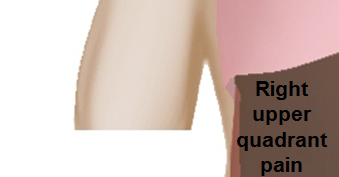 |
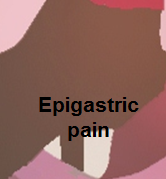 |
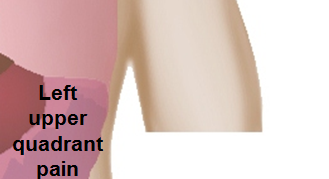
|
 |
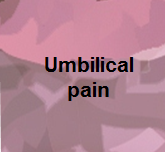 |

|
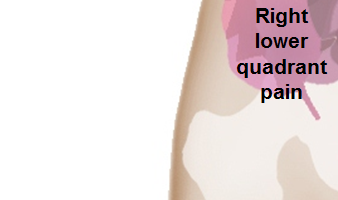 |
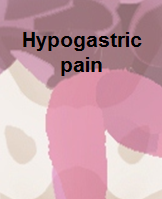 |
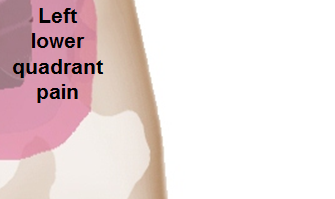
|
Differentiating Common Causes of Abdominal Pain
Shown below is a table summarizing some clues that help to distinguish the presentation of different diseases.
| Causes | Clues |
| Appendicitis | Gradual achy pain that starts as diffuse periumbilical pain, then becomes localized in the right lower quadrant. |
| Cholecystitis | Acute constricting pain that starts localized in the right upper quadrant and sometimes radiates to the scapula. |
| Pancreatitis | Acute boring pain that starts in the epigastrium and radiates to midback. |
| Diverticulitis | Gradual achy pain, localized in the left lower quadrant (called left sided appendicitis). |
| Perforated peptic ulcer | Sudden burning pain, presents as a diffuse pain in the periumbilical region. |
| Small bowel obstruction | Gradual crampy pain, presents as a diffuse pain in the periumbilical region. |
| Mesenteric ischemia or infarction | Sudden agonizing pain, presents as a diffuse pain in the periumbilical region. |
| Ruptured abdominal aortic aneurysm | Sudden tearing pain, presents as a diffuse pain in the abdomen, back and flanks. |
| Gastroenteritis | Gradual spasmodic pain, presents as a diffuse pain in the periumbilical region. |
| Pelvic inflammatory disease | Gradual achy pain, presents in either lower quadrants or pelvis and sometimes radiates to the upper thigh. |
| Ruptured ectopic pregnancy | Sudden sharp pain, presents in either lower quadrants or pelvis. |
Do's
- Start the approach to acute abdominal pain by rapid assessment of the patient using the pneumonic "ABC:" airway, breathing and circulation, to identify unstable patients.
- Consider abdominal aortic aneurysm, mesenteric ischemia and malignancy in patients above 50 years as it is much less likely for younger patients.
- Perform pelvic and testicular examination in patients with low abdominal pain.
- Re-examine patients at high risk who were initially diagnosed with pain of unclear etiology.
- Taking careful history, characterizing the pain precisely and thorough physical examination is crucial for creating narrow differential diagnosis.
- Correlate the CD4 count in HIV positive patients with the most commonly occurring pathology.
- Order a pregnancy test before proceeding with a CT scan in females in the child bearing age.
- Order an ultrasound or magnetic resonance among pregnant females to avoid exposure to radiation. In case the previous tests were inconclusive and appendicitis is suspected, the next step in the management includes proceeding with either laparoscopy or limited CT scan.
- Consider peritonitis with cervical motion tenderness as it isn't specific for pelvic inflammatory disease.
- Suspect abdominal aortic aneurysm in old patients presenting with abdominal pain with history of tobacco use.[1]
- Suspect acute mesenteric ischemia or acute pancreatitis in patients presenting with poorly localized pain out of proportion to physical findings.[1]
- Recommend initial imaging studies based on the location of abdominal pain:
- Ultrasonography is recommended when a patient presents with right upper quadrant pain.[2]
- Computed tomography (CT) with intravenous contrast media is recommended for evaluating adults with acute right lower quadrant pain.[2]
- CT with oral and intravenous contrast media is recommended for patients with left lower quadrant pain.[2]
- Order ECG for old patients with upper abdominal pain with high cardiac risk factors.
- Administer narcotic analgesia for patients who present to the ED with moderate or severe abdominal pain.[3]
- Perform diagnostic paracentesis (cell count, differential count, gram stain, culture, bilirubin and albumin) in patients with ascites and abdominal pain to rule out spontaneous bacterial peritonitis.
Don'ts
- Fail to evaluate elder patients in the presence of overt clinical signs.
- Over rely on laboratory tests, they are only used as adjuncts.
- Do not delay the initial intervention.
- Do not order blood cultures routinely in all patients
- Don’t delay resuscitation or surgical consultation for ill patient while waiting for imaging.
- Don’t restrict the differential diagnosis of abdominal pain based on the location; for example, right-sided structures may refer pain to the left abdomen.[1]
References
- ↑ 1.0 1.1 1.2 "Diagnosis and management of 528 abdom... [Br Med J (Clin Res Ed). 1981] - PubMed - NCBI".
- ↑ 2.0 2.1 2.2 "http://www.acr.org/". External link in
|title=(help) - ↑ "http://www.ebmedicine.net/content.php?action=showPage&pid=94&cat_id=16". External link in
|title=(help)